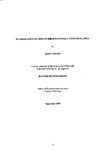FLUORESCENCE STUDIES IN THE INDUCTIVELY COUPLED PLASMA
| dc.contributor.author | YOUNG, ANITA | |
| dc.contributor.other | Faculty of Science and Engineering | en_US |
| dc.date.accessioned | 2013-09-13T10:02:05Z | |
| dc.date.available | 2013-09-13T10:02:05Z | |
| dc.date.issued | 2002 | |
| dc.identifier | NOT AVAILABLE | en_US |
| dc.identifier.uri | http://hdl.handle.net/10026.1/1686 | |
| dc.description.abstract |
An Optima 3000 ICP-AES instrument was modified and the equipment necessary to carry out axial excitation atomic fluorescence was designed and constructed. Using this calibrated system, preliminary fluorescence experiments were not successful. As fluorescence is proportional to source intensity, it was considered that the excitation source, a hollow cathode lamp, may not have been sufficiently intense to produce fluorescence. A novel excitation source-driver system was designed and built in-house to operate HCLs, BDHCLs and LEDs with variable modulation frequencies and duty cycle capabilities. Studies investigating lamp response to changes in modulation frequency and duty cycle indicated that a lamp operated with a lower modulation frequency range (167 - 542 Hz) and higher duty cycles (30 - 50 %) should provide the preferred intense excitation conditions for the production of fluorescence in the ICP, When a Thermo Elemental PQ2 instrument was used, fluorescence was obtained immediately. Um'variate searches were used to optimise several plasma parameters, i.e. forward power; viewing height ALC; plasma, nebuliser and auxiliary gas flow rates. Once the optimum conditions had been determined, calibration curves were plotted for each of the elements studied (Ba, Li, Mg and Na). The calibration showed excellent linearity over five orders of magnitude (R? values ranged from 0.99995 to 1.0000) and the precision on each data point was better than 5 % RSD. Limits of detection were determined to be 27.6, 0.51, 0.43 and 0.20 ug 1* for Ba, L i , Mg and Na, respectively, which approached those reported in the literature for a commercial system. Vertical profiles of the plasma, using radial excitation, were obtained for Ba, Li , Mg and Na. Using the optimum conditions for Li and Na, vertical profiles of the plasma, using axial excitation with the more intense LEDs, were obtained. Both profiles showed that there was a relatively sharp optimum, with respect to fluorescence signal, as a function of viewing height ALC. The optimum viewing heights ALC obtained, for both radial and axial excitation fluorescence, were identical, suggesting that, irrespective of the excitation arrangement employed, only particular conditions produced in the plasma give the optimum conditions for fluorescence and that these are spatially dependent. Plasma diagnostics were performed in an attempt to explain why fluorescence was observed using the plasma produced by the Thermo Elemental but not by the Optima 3000 generator. At a viewing height of 50 mm ALC, Texc and Trot were 3080 and 2500 K for plasmas produced using the Thermo Elemental generator and 3600 and 2830 K for the Optima 3000 generator, respectively. Temperatures were calculated using the mean emission intensity at particular wavelengths. The intensities of the emitting species from the Thermo Elemental ICP were lower than those obtained from the Optima 3000 ICP for supposedly 'identical' conditions. If the number of excited species gives rise to lower emission intensities, then there must be more atoms in the lower/ground state from the plasma produced using the Thermo Elemental generator. This is of vital importance because for fluorescence to occur the fluorescence emission intensity will be dependent on the number available in the ground state for excitation {i.e. a relatively 'cool' plasma is required for fluorescence to occur). As very similar plasma operating conditions and the same concentration solutions were used in the fluorescence experiments performed using both the Optima 3000 and the Thermo Elemental ICPs, the differences observed in plasma performance may be attributed to efficiency of coupling of the generators used. | en_US |
| dc.language.iso | en | en_US |
| dc.publisher | University of Plymouth | en_US |
| dc.title | FLUORESCENCE STUDIES IN THE INDUCTIVELY COUPLED PLASMA | en_US |
| dc.type | Thesis | |
| plymouth.version | Full version | en_US |
| dc.identifier.doi | http://dx.doi.org/10.24382/1532 |
Files in this item
This item appears in the following Collection(s)
-
01 Research Theses Main Collection
Research Theses Main


